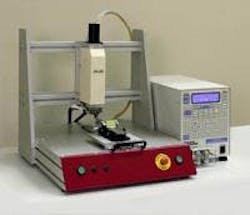Desktop Bonders
The Desktop Bonders use pneumatic bonding heads with the company’s uniquely designed Quick Connect Blocks and Thermo-plane Thermodes. The exclusive thermode design offers ultra-fast heating and cooling cycles, which minimize process times. Forced air-cooling after the heating process further speeds the total bonding process. The thermode is designed to maintain co-planarity and withstand deformation that tends to occur in some bonding processes. Another key design feature is the elimination of voltage drop as current flows from front-to-back instead of left-to-right, preventing damage to the parts when soldering.
The series includes a range of product handling features to tailor the bonder for use in particular applications, including left-right and front-rear slides, as well as rotary tables. Left-right and rotary models are ideal for higher throughput or higher volume applications, including production of cell phone parts. Models with in-out slides facilitate loading and unloading and visual alignment of parts, with or without a camera. The slide modules operate either manually or pneumatically and have an option for three-stop positions, which is specially designed for two bonding locations on a single printed circuit board (PCB), extremely useful for a flex to LCD and PCB bonding process. Additional options for the desktop series include optical alignment, Kapton feeder, water-cooling, and interposer modules, as well as customized product jigs.Each of the desktop units in the series is connected to and powered by Miyachi Unitek’s powerful and flexible Uniflow3® power supply system for pulse-heated, selective soldering, conductive adhesive bonding and thermocompression bonding. The Uniflow3 provides targeted heating and precision temperature control for such components as flex circuits, ribbon cables, wires, SMT components, single or dual sided edge connectors and thermocompression bonding of gold ribbon.
- uses pneumatic bonding heads
- left-right and front-rear slides
- thermode design offers ultra-fast heating and cooling cycles
